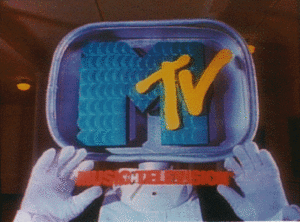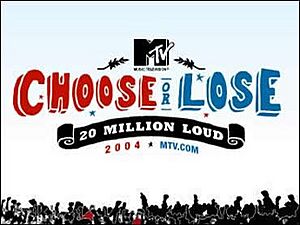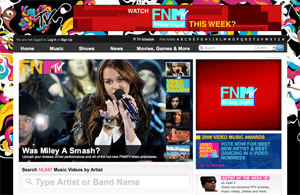MTV facts for kids

Logo since September 9, 2021, paying homage to the original 1981 logo
|
|
| Type | Music channel (formerly) Entertainment |
|---|---|
| Country | United States |
| Broadcast area | United States Canada |
| Headquarters | One Astor Plaza, 1515 Broadway, Times Square, Manhattan, New York, NY |
| Programming | |
| Language(s) |
|
| Picture format | 1080p HDTV |
| Timeshift service | MTV East (New York City) MTV West (Los Angeles) |
| Ownership | |
| Owner | Paramount Media Networks (Paramount Skydance Corporation) |
| Parent | MTV Entertainment Group |
| Sister channels |
List
|
| History | |
| Launched | August 1, 1981 |
| Founder |
|
| Former names |
|
| Availability | |
| Streaming media | |
| Affiliated Streaming Service | Paramount+ |
| Service(s) | FuboTV, Hulu + Live TV, Philo, Sling TV, YouTube TV |
MTV stands for Music Television. It is a famous American TV channel. It started on August 1, 1981. At first, MTV showed mostly music videos. It also had TV hosts called video jockeys (VJs).
MTV quickly became popular around the world. It helped make cable TV a big deal in the 1990s. Over time, MTV changed its focus. It now shows more reality TV shows for teenagers and young adults. As of November 2023, about 67 million homes in the United States could watch MTV. This number was higher in 2011, when 99 million homes watched it.
Contents
How MTV Started: A Look at Its History
MTV began broadcasting on August 1, 1981, at 8:00 p.m. It was owned by Warner-Amex Satellite Entertainment. The very first music video played on MTV was “Video Killed the Radio Star” by The Buggles.
In 1984, MTV became part of a new company called MTV Networks. This company is now known as Paramount Media Networks. Later, in 1985 and 1986, Viacom bought MTV Networks.
What to Watch: MTV's Programming
As MTV grew, it started showing more than just music videos. The channel now has many different types of shows. These shows are for teenagers and young adults. MTV airs its own original shows. It also shows programs from other channels owned by Paramount.
MTV also makes movies for young adults. These movies are released in theaters or made for TV.
In 2010, a study found that MTV had a lot of content about gay, bisexual, and transgender people. This was the highest percentage in the TV industry at that time.
In 2018, MTV created a new group called MTV Studios. This group makes new versions of MTV's older shows. It later became part of MTV Entertainment Studios.
The MTV Video Music Awards (VMAs)
In 1984, MTV held its first MTV Video Music Awards show. These awards are often called the VMAs. At the first show, Madonna performed her song "Like a Virgin". The trophies given out at the VMAs look like the MTV moon-man. This moon-man was MTV's original image from its first broadcast. The VMAs were MTV's most-watched yearly event as of 2012.
Fun Events: MTV's Annual Specials
MTV started its yearly Spring Break coverage in 1986. For a week in March, MTV would broadcast live from Daytona Beach, Florida. An MTV vice president said they wanted to be part of this youth event.
The channel also held beach-themed events in the summer. They would broadcast live from a beach house in different places. This led to special summer themes for the whole channel. Examples include Motel California and Isle of MTV. MTV VJs would host music videos and interview artists from these beach locations.
MTV also had week-long music events. These events would take over the channel's look. In the 1990s and 2000s, these included All Access Week for live concerts. Spankin' New Music Week showed brand new music videos.
At the end of each year, MTV broadcasts live from Times Square in New York City. This happens on New Year's Eve. They feature live music and interviews with popular artists. For many years, a band would perform a cover song right after midnight.
Live Concerts and Special Broadcasts
MTV has shown many global benefit concerts live. On July 13, 1985, MTV broadcast the Live Aid concerts. These concerts raised money for people in Ethiopia. While other networks showed only parts, MTV broadcast 16 hours of the event.
On July 2, 2005, MTV also broadcast the Live 8 concerts. These concerts happened before a big meeting of world leaders. MTV received some criticism for its Live 8 coverage. Some viewers felt the network cut to commercials too often. They also disliked VJs talking during performances. MTV later aired five hours of uninterrupted Live 8 coverage to address these concerns.
MTV's Look: Logo and Branding

MTV's first logo was created in 1981. It had a big "M" and a scribbled "TV". The "M" was often yellow and the "TV" was red. But unlike other TV logos, MTV's logo changed its colors and patterns all the time. It appeared in many different styles. The only things that stayed the same were its general shape and size.
MTV launched with a special video showing the first Moon landing. This video then showed the MTV logo on the Moon. The logo quickly changed colors and patterns. This video was shown at the top of every hour until 1986. The Moonman later became a big part of MTV's brand, especially for its award shows.
From the late 1990s to early 2000s, MTV updated its on-air look every year. This created a consistent style for its music shows. This style ended when MTV showed fewer music-related programs. Around this time, MTV started using a simple, single-color logo on screen.
In 2010, MTV changed its official logo. The words "MUSIC TELEVISION" were removed. The bottom of the "M" was cut off, and the "V" in "TV" no longer branched out. This change showed that MTV was focusing more on reality and comedy shows. Like the old logo, the new one could be filled with many different images.
In 2015, MTV International updated its look with new graphics. These graphics had a vaporwave and seapunk style. Some people thought this style was meant to criticize big companies, not be used by them. MTV also launched MTV Bump and MTV Canvas. These websites let users submit videos and custom designs to be shown on TV.
On February 5, 2021, MTV started using a new logo. This logo is a simpler version of the 2010 one. It also uses the red-yellow-blue colors from MTV's past. This new logo was fully rolled out by the 2021 MTV Video Music Awards.
"I Want My MTV!" Campaign
The famous "I Want My MTV!" advertising campaign started in 1982. It featured popular artists and celebrities. These stars included Mick Jagger, Madonna, and David Bowie. They encouraged viewers to call their TV providers. They wanted people to ask for MTV to be added to their channel lineup.
The slogan became so well-known that Sting sang it in the Dire Straits song "Money for Nothing". This song's music video was played often on MTV.
Making a Difference: MTV's Social Activism
MTV has a long history of encouraging young people to get involved. They promote social, political, and environmental causes. Their campaigns include Choose or Lose, Fight For Your Rights, and MTV Act.
Choose or Lose: Encouraging Voting
In 1992, MTV started Choose or Lose. This campaign encouraged over 20 million people to register to vote. MTV also hosted a town hall meeting for then-candidate Bill Clinton.
MTV has also aired programs like True Life, which shows people's real-life problems. MTV News specials cover current events. For example, a special show covered the 2004 US presidential election. It focused on young people's opinions. MTV also worked with P. Diddy's "Citizen Change" campaign to encourage young people to vote.
MTV also showed a documentary about the music group Sum 41 in the Democratic Republic of the Congo. It showed the conflict there. The group was caught in an attack and had to leave the country.
During the 2008 US presidential election, MTV started showing presidential campaign commercials.
Rock the Vote: Get Out and Vote
MTV works with Rock the Vote. This campaign helps young adults register to vote. It also encourages them to cast their ballots.
MTV Act and Power of 12
In 2012, MTV launched MTV Act and Power of 12. MTV Act focuses on many social issues. Power of 12 replaced Choose or Lose. It focused on the 2012 US presidential election.
Elect This: For the 2016 Election
In 2016, MTV continued its pro-democracy efforts with Elect This. This campaign looked at the 2016 election for young people. It included short animations, digital series, and a political podcast.
Vote Early Day: Making Voting Easier
In 2020, MTV helped create Vote Early Day. This day encourages people to vote before Election Day. It was first aimed at young voters. The campaign works with many different groups and brands.
More Than Just One Channel: The MTV Family
Since 1981, the "MTV" brand has grown a lot. It now includes many other channels and websites.
Sister Channels in the United States
MTV has a group of sister channels. These are part of Paramount Media Networks. In 1985, MTV launched its first sister channel, VH1. VH1 originally played adult contemporary music videos. Now, VH1 focuses on celebrity and pop culture reality shows. Another sister channel, CMT, focuses on country music and Southern culture.
With satellite and digital cable, MTV added more channels. These include MTV2 and the Spanish-speaking MTV Tr3́s (Tr3́s). These channels first played music videos but later changed their programming. MTV also used to broadcast MTVU on college campuses. MTV also had MTV Hits and MTVX channels. These later became NickMusic and MTV Jams. MTV Jams was then renamed BET Jams in 2015.
In 2006, MTV launched MTV HD. This is a high-definition version of the channel. Most TV providers offer MTV HD.
MTV Networks also runs MTV Live. This is a high-definition channel that shows music programs from MTV, VH1, and CMT. It started as MHD (Music: High Definition) in 2006. It became MTV Live in 2016.
From 2005 to 2007, MTV launched channels for Asian Americans. These included MTV Desi for Indian Americans, MTV Chi for Chinese Americans, and MTV K for Korean Americans. These channels showed music videos and shows from MTV's international channels. All three channels stopped broadcasting in 2007.
On August 1, 2016, MTV Classic was launched. This was the 35th anniversary of MTV's original launch. MTV Classic shows classic music videos and programs from the 1980s, 1990s, and 2000s. It also airs old MTV shows like Beavis and Butt-Head. The channel's launch included a broadcast of MTV's first hour on air. This was also shown on MTV and Facebook Live. MTV Classic had few viewers and became one of the least-watched English-language channels by the end of 2016. In 2017, it became an all-video network.
MTV Online: The Internet Presence
In the late 1980s, before the Internet was widely used, MTV VJ Adam Curry started exploring online. In 1993, he registered the website name "MTV.com". He wanted it to be MTV's unofficial voice online. Later, MTV sued him for the name, and they settled out of court.
The website was first called "MTV Online" in the mid-1990s. It was a place to find MTV content online. Later, it became known as "MTV.com". It became the main place for all MTV and MTV News content.
From 2005 to 2007, MTV.com tried a video-based design. It started with MTV Overdrive, a streaming video service. After the 2006 MTV Video Music Awards, MTV.com changed to a full Flash video site. Many users did not like this. They complained about videos playing automatically and slow speeds. The experiment ended in 2007. MTV.com went back to a regular website design with embedded video clips.
From 2006 to 2007, MTV also had an online channel called MTV International. It showed music videos without commercials. This was because the TV channels were showing fewer music videos.
In 2008, MTV launched MTV Music (later called MTV Hive). This website had thousands of music videos from MTV and VH1. It included videos from as far back as 1981.
A new part of the company, MTV New Media, started making its own online shows in 2008. These shows could be watched on computers, phones, and other devices.
In 2012, MTV launched a music discovery website called the MTV Artists Platform. This site helps fans find and buy music. It also helps them buy concert tickets and merchandise.
MTV.com is still the official website for MTV. It offers more content than what is shown on TV. In 2022, it changed to mostly direct people to content on Paramount+ and Pluto TV. The site used to have an online version of MTV News and podcasts. The news site is no longer active, but you can still find old movie features and interviews there. An MTV app is also available on phones and smart TVs.
See also
 In Spanish: MTV para niños
In Spanish: MTV para niños
- History of MTV
- List of MTV award shows
- List of MTV channels
- MTV Canada
- MTV Australia and New Zealand
- MTV Latin America
- MTV Global
- Music industry
Images for kids
-
The first images shown on MTV were a montage of the Apollo 11 moon landing.
-
One of many MTV station IDs used during the 1980s, this one was designed by Henry Selick.


















